The 50 greatest Chopin recordings
Gramophone
Sunday, January 1, 2023
Complete with the original Gramophone reviews of 50 of the finest Chopin recordings available
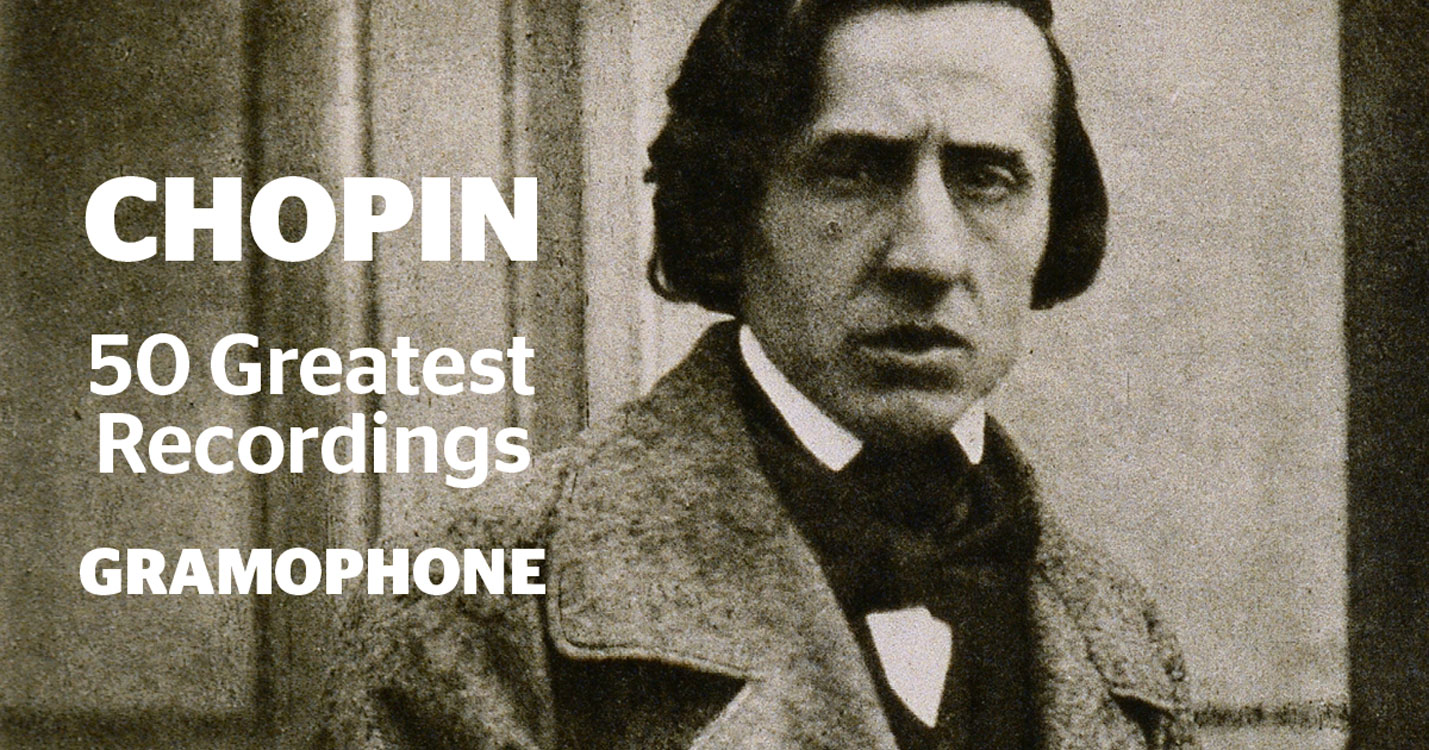
Our lists of the 50 greatest Mozart, Beethoven and Bach recordings have proved phenomenally successful, and so we are proud to present 50 of the finest recordings of Chopin's music. Included here are Gramophone Award-winning albums, Recordings of the Month and Editor's Choice discs from Rubinstein, Argerich, Pollini, Perahia, Cortot, Grosvenor, and many more. We have included, where possible, the complete original Gramophone reviews, which are drawn from Gramophone's Reviews Database of more than 45,000 reviews. To find out more about subscribing to the Database, visit: gramophone.co.uk/subscribe. All of these lists are, of course, subjective, but every recording here has recieved the approval of Gramophone's critics and are artistic and musical benchmarks. If you want to hear Chopin performance at its best, this list is the perfect place to start.
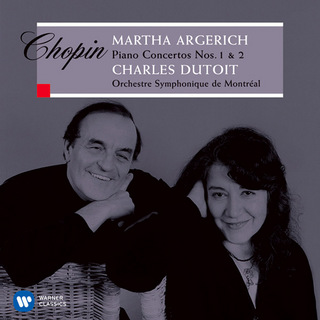
Piano Concertos
Martha Argerich pf Montreal Symphony Orchestra / Charles Dutoit
(Warner Classics)
Martha Argerich’s first commercially released recordings of the Chopin concertos were for DG; No 1 in 1968, No 2 in 1978. Here she revisits both concertos and offers an act of re-creative daring, of an alternating reverie and passion that flashes fire with a thousand different lights. Indeed, her earlier performances are infinitely less witty, personal and eruptive, less inclined to explore, albeit with the most spontaneous caprice and insouciance, so many new facets, angles and possibilities. Now, everything is accomplished without a care for studios and microphones, and with a degree of involvement that suggests an increase rather than a diminution of her love for these works. The recordings are impressively natural and if Dutoit occasionally seems awed if not cowed into anonymity by his soloist (the opening tuttis to the slow movements of both concertos are less memorable than they should be) he sets off Argerich’s charisma to an exceptional degree. Argerich’s light burns brighter than ever. Rarely in their entire history have the Chopin concertos received performances of a more teasing allure, brilliance and idiosyncrasy.
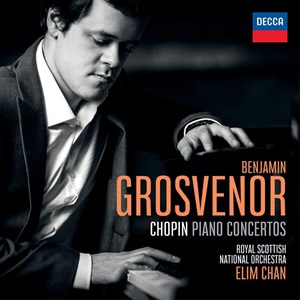
Piano Concertos
Benjamin Grosvenor pf Royal Scottish National Orchestra / Elim Chan
(Decca)
'When Benjamin Grosvenor finally makes his first entrance, it proves well worth the wait, and his playing beguiles from the off; as the dynamics sink, his lines are full of poetry but they unfold with utter naturalness.'
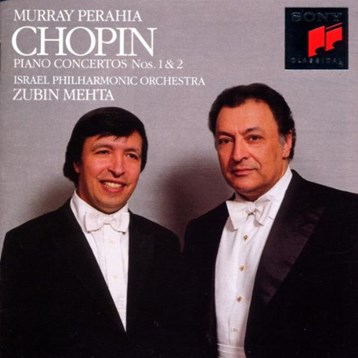
Piano Concertos
Murray Perahia pf Israel Philharmonic Orchestra / Zubin Mehta
(Sony Classical)
Perahia has never made any secret of his liking for the ‘inspirational heat-of-the-moment’ of a live performance as opposed to a studio recording, where ‘sometimes things get tame’. As enthusiastic audience applause (discreetly rationed on the disc) makes plain, these two concertos were recorded live at Tel Aviv’s Mann Auditorium. Whether they were subsequently ‘doctored’ we don’t know, but the finished product brings us a Perahia miraculously combining exceptional finesse with an equally exceptional urgency. In all but the finale of No 1 (where Pollini on EMI beats him by a minute) his timings throughout both works are considerably faster than most of his rivals on disc. Was this prompted by ‘inspirational heat-of-the-moment’? Or was it a deliberate attempt to come closer than others do to the surprisingly briskish metronome markings printed in the Eulenburg scores? The two slow movements are distinguished by exquisitely limpid cantabile and superfine delicacy of decorative detail while again conveying urgent undercurrents. But in a guessing game perhaps it would be the two finales that would most betray the identity of the soloist. Not only are they faster, but they are also of a more scintillating, scherzando-like lightness. The recording is first rate.
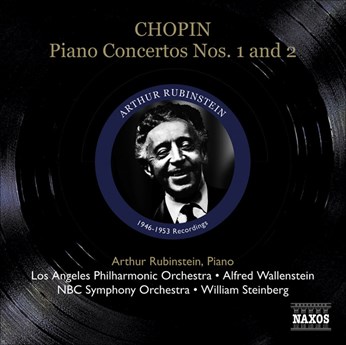
Piano Concertos
Arthur Rubinstein pf Los Angeles Philharmonic Orchestra / Alfred Wallenstein; NBC Symphony Orchestra / William Steinberg
(Naxos Historical mono)
Recorded 1953, 1946
Mercifully uncut, unlike Rubinstein’s previous discs of both concertos with Barbirolli, these are astonishing performances, occasionally, particularly in the Second Concerto, content simply to astonish. Here there is an almost arrogant dismissal of all difficulties and a prima donna stance sometimes hard to square with some of Chopin’s more delicate and ornate confidences. In the scintillating coda Rubinstein takes his bravura to a spine-tingling edge, but in, for example, the Larghetto’s central storms there is a brusque, streamlined indifference to the music’s finer qualities.
In the First Concerto, while recognisably the same pianist, Rubinstein is altogether more subtle, following his characteristic exuberance and extroversion with playing of a rapt magic and delicacy. The music may be sent smartly on its way by both conductor and soloist, but the patrician ease, nonchalant glitter and authority of Rubinstein’s playing are uniquely his to command. These are both extraordinary performances by an extraordinary pianist, though of the two, the First Concerto is the more affecting. Mark Obert-Thorn’s restoration of the 1953 sound is a model of remastery though even he cannot make the 1946 Second Concerto sound less than cramped.
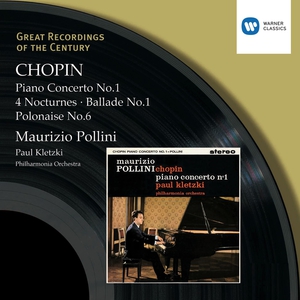
Piano Concerto No 1. Ballade in G minor, Op 23. Nocturnes. Polonaise No 6, ‘Heroic’
Maurizio Pollini pf Philharmonia Orchestra / Paul Kletzki
(Warner Classics)
Recorded 1960, 1968
This disc is a classic. The concerto was recorded shortly after the 18-year-old pianist’s victory at the Warsaw competition in 1959. Nowadays we might expect a wider dynamic range to allow greater power in the first movement’s tuttis but in all other respects the recording completely belies its age, with a near-perfect balance between soloist and orchestra. This is very much Pollini’s disc, just as the First Concerto is very much the soloist’s show, but effacing as the accompaniment is, Pollini’s keyboard miracles of poetry and refinement could not have been achieved without one of the most characterful and responsive accounts of that accompaniment ever committed to tape. The expressive range of the Philharmonia on top form under Kletzki is exceptional, as is the accord between soloist and conductor in phrasing and shading. The solo items are a further reminder of Pollini’s effortless bravura and aristocratic poise.
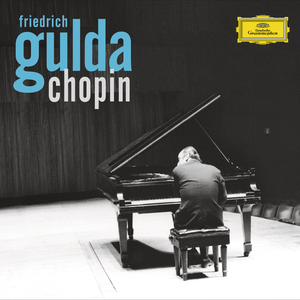
Piano Concerto No 1. Four Ballades. Barcarolle. Nocturnes. Preludes. Waltz No 14
Friedrich Gulda pf London Philharmonic Orchestra / Sir Adrian Boult
(DG)
Here in all his glory is Friedrich Gulda the ultimate maverick pianist, yet beneath his determined assault on what he saw as the stuffy conventions of the music world (the Viennese world in particular) lay a pianist of genius aptly described by Martha Argerich, his one-time protégée, as ‘the most extraordinary and brilliant man I ever met’.
Certainly all the live performances on these discs create a towering tribute to Chopin. Forever the nonconformist, Gulda may sometimes be wilful and irascible but he is never less than mesmeric and fascinating. Time and again he casts a novel and intense light on even the most familiar phrase, making you hang on every note. Try Prelude No 14 for a virtuoso savagery beyond the world of other more ‘civilised’ pianists, or No 13 where Gulda’s rapture makes the music stretch seemingly to infinity. Again there may be moments in the Ballades and Barcarolle where the playing verges on hysteria but the sheer mastery and strength are like an elemental force of nature. Even when he takes a rough hand to some of Chopin’s more intimate confessions, his way with his selection of Nocturnes creates a sense of drama and occasion light years away from more recent recordings.
The First Concerto is given in Balakirev’s touched-up version and if in the studio Gulda’s playing is more disciplined, less free-thinking, it is also of a special imaginative delicacy and engagement. The programme ends with Gulda’s own Epitaph for a Love, a strange mixed-up jazz effusion that includes some very odd vocals in Viennese dialect and a phantom reference to Chopin’s C minor Prelude. The pianist’s son, Paul Gulda, writes a moving and informative essay clarifying much of his father’s complexity and telling us, perhaps not surprisingly, that Alfred Cortot was among his chief musical idols.
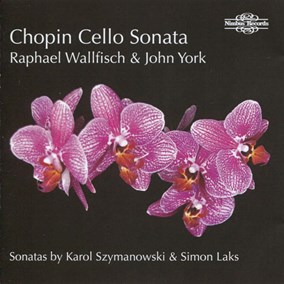
Cello Sonata. Etude, Op 10 No 6
Raphael Wallfisch vc John York pf
(Nimbus)
The performance of the Chopin Sonata is unusually successful. One is often conscious in this work of a mismatch between the characteristic elaboration of the piano part and the writing for cello, generally more plain and unadorned, but Raphael Wallfisch’s eloquence disposes of any problem; the two instruments, each with its distinctive role, balance one another perfectly. There’s an air of spontaneity, yet the expressive weight of each phrase is carefully considered, by York as well as by Wallfisch, giving the whole work a powerful sense of unity.
York and Wallfisch adopt a no-holds-barred approach to the ultra-romantic Szymanowski, a successful transcription of his early Violin Sonata. Their grand gestures carry complete conviction and sweep us along, even over the finale’s obsessive repetitions.
Simon Laks had already settled in Paris when he wrote his 1932 Cello Sonata. There are echoes of Les Six, Stravinsky and Ravel, whose G major Violin Sonata surely provided the model for the languid, bluesy middle movement. It’s a deftly composed, attractively varied work and, as with the other items, the performance is exemplary.
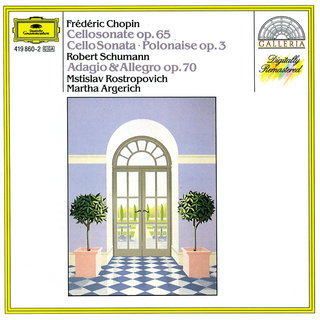
Cello Sonata. Introduction and Polonaise brillante in C
Mstislav Rostropovich vc Martha Argerich pf
(DG)
The recording by Paul Tortelier and Aldo Ciccolini of the last work Chopin published (Paris, 1847), which they couple with Rachmaninov's Sonata, has been a favourite of mine since it appeared. But I am at last almost persuaded that it has been supplanted. In fact, both that performance and this one by Mstislav Rostropovich and Martha Argerich are of strongly marked character, acutely, though differently, responsive to the music's every inflection, and both provide deep satisfactions. The Tortelier recording is somewhat warmer, the separation between the instruments better defined; yet this recording is excellent also.
A lesser known Chopin work for cello and piano is the Introduction and Polonaise brillante, Op 3 (though it is not so little known as his Grand Duo on themes from Meyerbeer's Robert Ie Diable). He wrote the Polonaise in October 1829, adding a touching Introduction the following July. This new performance is easily the best I have ever heard and one particularly enjoys the counterpoint of slow cello and fast piano, of ardent lyricism and exuberant virtuosity. This is altogether a recording of magnificent playing.
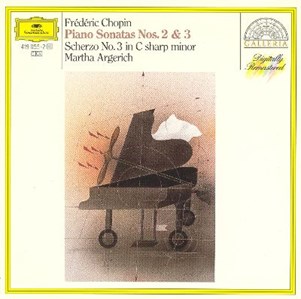
Piano Sonatas Nos 2 & 3. Scherzo No 3
Martha Argerich pf
(DG)
Recorded 1975, 1967, 1961
Here, simply and assuredly, is one of the most magisterial talents in the entire history of piano playing. She’s hardly a comfortable companion, confirming your preconceptions. Indeed, she sets your heart and mind reeling so that you positively cry out for respite from her dazzling and super-sensitive enquiry. But she’s surely a great musician first and a great pianist second. From her, Chopin is hardly the most balanced or classically biased of the Romantics. She can tear all complacency aside. How she keeps you on the qui vive in the Second and Third Sonatas. Is the Funeral March too brisk, an expression of sadness for the death of a distant relative rather than grief for a nation? Is the delicate rhythmic play at the heart of the Third Sonata’s Scherzo virtually spun out of existence? Such qualms or queries tend to be whirled into extinction by more significant felicities. Who but Argerich, with her subtle half-pedalling, could conjure so baleful and macabre a picture of ‘winds whistling over graveyards’ in the Second Sonata’s finale, or achieve such heart-stopping exultance in the final pages of the Third Sonata (this performance is early Argerich with a vengeance, alive with a nervous brio). And if her free spirit leaves us tantalised, thirsting for Chopin’s First, Second and Fourth Scherzos as well as his Third, for example, she has also left us overwhelmingly enriched, forever in her debt.
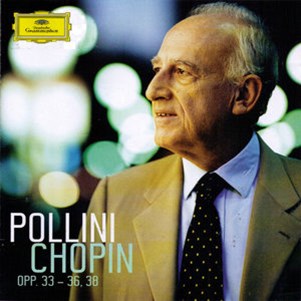
Piano Sonata No 2. Ballade No 2. Mazurkas Nos 22-25. Waltzes Nos 2-4. Impromptu No 2
Maurizio Pollini pf
(DG)
The programme embraces Chopin’s Opp 33‑38 with the exception of the two Nocturnes, Op 37, though they’re not played in chronological order. Pollini begins with a magnificent account of the Ballade No 2, the maelstrom that erupts after the pastoral first page sounding like a howl of despair. The four Mazurkas, Op 33, and three Waltzes, Op 34, not only form a contrast to the Ballade but are themselves contrasted with each other. The F sharp major Impromptu, almost a mini-ballade, is heard in another refined account, Pollini relishing the leggiero jeu perlé scale passagework at the close. In the Second Sonata, Pollini unites what Schumann called ‘four of [Chopin’s] wildest children’ into a family, a feat managed by few pianists, the first movement (with a da capo repeat) leading quite naturally into the Scherzo and so on.
It’d be difficult for Pollini to produce an ugly sound (and he doesn’t here), but while the piano is captured from a slight distance (say the front row of the stalls), the pianist’s frequent nasal intakes of breath are recorded in close-up.
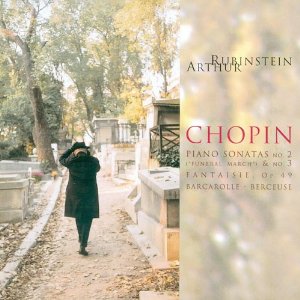
Piano Sonatas Nos 2 & 3. Fantasie, Op 49
Arthur Rubinstein pf
(RCA Victor Red Seal)
In the Chopin sonatas it’s difficult to think of which performance to choose as the greatest. Aside from the Funeral March itself, Rubinstein’s account of the Second Sonata is a bit too imperious; the Third is much more thrilling, with considerable technical risks being taken both in the first movement and the finale. His own feeling for quiet nuances in the Largo of this work is quite superb, and here too Pollini on DG achieves an innocence that’s disarming. Pollini’s disc is the most perfect, both in terms of the pianist’s technical accomplishment and the lucid piano sound, with nothing that offends the ear. The middle treble range in Rubinstein’s piano sound has a hollow resonance. Rubinstein tackles the F minor Fantasie in rather a heavy-handed manner, with more power than searching drama. If you want your Chopin sonatas balanced and formally cohesive, then Rubinstein is for you.
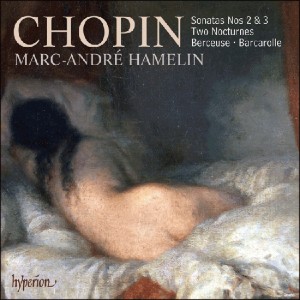
Piano Sonatas Nos 2 & 3. Barcarolle, Op 60. Berceuse, Op 57. Nocturnes Nos 7 & 8
Marc-André Hamelin pf
(Hyperion)
This is a disc that takes you by stealth. Not simply because it opens almost unassumingly, with a finely wrought Berceuse, but because it was only after several listenings that one realises just how good it is. This is Hamelin’s second recording of the Second Sonata and it shows how much his pianism has developed during the intervening time.
Hamelin’s playing is refreshingly free from the ‘inverted comma’ school of profundity, and he lets the music speak through him most eloquently; he doesn’t get carried away with the subtext of the Second’s Funeral March, keeping it flowing (with desynchronisation of the hands subtly done) and all the more effective as a result. In the slow movement of the Third he finds time to dream without ever becoming portentous, and is every bit the equal of Nelson Freire (Decca), whose Chopin sonatas have rightly won considerable praise. Predictably, Hamelin is wonderful in such things as the Scherzo of the Third and the visceral finale of the Second, though perhaps slower than you might expect in the neurotic Scherzo of No 2. In the finale of the Third he doesn’t begin the build-up too soon, as can be a temptation, and even has a skip in his step.
The addition of two Nocturnes and the sublime Barcarolle simply confirm that though Hamelin has made many fabulous discs, particularly in repertoire of superhuman virtuosity, this is one of his very finest achievements to date.
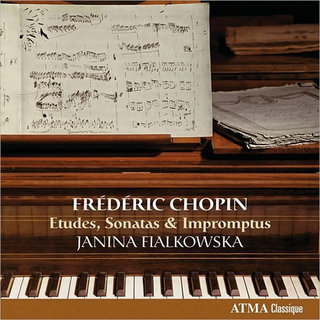
Piano Sonatas Nos 2 & 3. Etudes. Impromptus Nos 1-3. Fantaisie-impromptu
Janina Fialkowska pf
(ATMA Classique)
Lesser mortals may well weep with envy at such unfaltering authority and one hesitates even to imagine the hours of work behind such magnificence. What a glittering and assured curtain-raiser to the Op 10 Etudes; and if she can command with the best of them she can just as easily take you into her confidence. No 3 is, for once, truly Lento though with a marked sense of character in the central Poco più animato, while in No 6 Fialkowska is hauntingly responsive to Chopin’s nameless malaise. How perfectly she judges the echoing mountain-calls in No 9, while even the most seasoned pianist might despair over her fleetness in the Op 25 Etude ‘in thirds’.
Elsewhere she is grand and imperious in the Second Sonata, storming the first movement’s climax in towering and heroic fashion, and her demonic pace and drive make a true Mephisto-scherzo of the second movement. Her finale, while hardly sotto voce, opts for a more ferocious but intriguingly voiced alternative and she has all of the four Impromptus’ lighter charm and caprice at her fingertips. Her B minor Sonata is as thoughtful as it is masterly and if one occasionally misses the seductive tonal allure and magical cantabile of a Cortot or Perahia (most notably in the Largo), there’s admiration aplenty for such clarity, strength of purpose and musical integrity. Fialkowska offers an unfailing balance of sense and sensibility. Well recorded, she has done her one-time mentor, Arthur Rubinstein, proud.
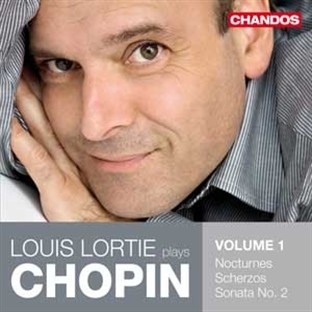
Piano Sonata No 2. Four Scherzos. Nocturnes
Louis Lortie pf
(Chandos)
The booklet’s ‘note from the performer’ for this first volume of a planned series of Chopin discs by Lortie raised a silent cheer. Other pianists should take note. Taking his lead from the days when pianists would improvise between selections to get the audience in the right mood, Lortie uses a Nocturne in a closely related key to preface each Scherzo. ‘I believe, moreover, that nobody really wants to sit down and listen to pieces of a single genre in a row…This practice…makes more sense by allowing the listener to enjoy the contents in one stretch.’
It’s a credo that serves Chopin’s genius far better than the default approach (it complements each Nocturne just as much as it does the Scherzos), the more so when the performances are as richly coloured and deftly articulated as these. Along the way there are some lovely individual touches like the way Lortie varies the dynamics in the exposition repeat of the First Scherzo, and the way he tiptoes querulously into the minor-key episode of the Third Scherzo. The soundscape of the recording is bit man-alone-in-empty-studio, and a da capo (rather than doppio movimento) repeat in the Sonata’s first movement always sounds clumsy. But these are minor cavils. This is Chopin-playing of a superior order.
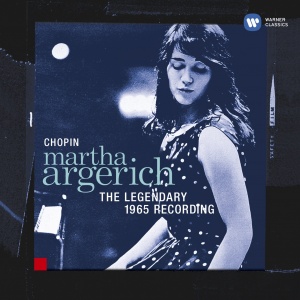
Piano Sonata No 3. Mazurkas Nos 36-38. Nocturne No 4. Polonaise No 6. Scherzo No 3
Martha Argerich pf
(Warner Classics)
Argerich’s pianism is remarkable for combining seemingly effortless technical resource with temperamental volatility. Yet the vehemence of her playing is seldom to the disadvantage of the extraordinary subtlety of her art. Moreover, despite the limits she places on her repertory, such is the spontaneity of her approach that each of her interpretations, no matter how familiar in broad outline, is characterised by a profusion of contrasting details beneath the surface. In the B minor Sonata she omits the first-movement repeats. Such a formal contraction can contribute to the momentum with which the movement unfolds. Ironically, however, she seems to rein in the propulsive power for which she’s renowned, appearing instead to be seeking at every turn to exploit a deeply felt exprssive lyricism to offset the febrile intensity of the most energetic figurational devices. This has the virtue of allowing us a less hectic view of subsidiary elements within the music, which elsewhere can too often be overwhelmed by the sheer turbulence of the action. Some of the most satisfying playing on the disc comes in her account of the Op 59 Mazurkas. There’s a vulnerability as well as an affecting wistfulness about the playing which captures the elusiveness of the idiom, with its harmonic ambiguities, with rare acuity. At the other end of the scale, the excitement she generates in the A flat Polonaise is of an order that goes far beyond mere effect. If these accounts do not necessarily outstrip her other recordings, they nevertheless offer an intriguing insight into a ‘work in progress’ from a pianistic giant whose artistry continues to fascinate and perplex.
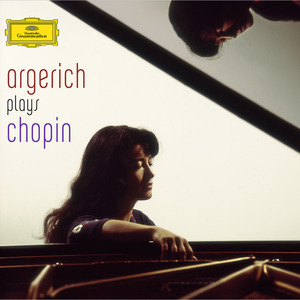
Piano Sonata No 3. Ballade No 1. Etudes. Mazurkas. Nocturnes
Martha Argerich pf
(DG)
Argerich first came to international prominence in 1965 when she won the Chopin Competition. The first track on this CD dates from six years earlier, a blistering performance of the G minor Ballade recently unearthed in the archives of Deutschlandradio Kultur (formerly RIAS) in Berlin. The work is new to Argerich’s discography but, though it will not worry her legions of admirers, neither the recorded sound nor the duff piano are things of aural beauty.
There is a marked improvement in these respects in the following selections of Mazurkas and Nocturnes recorded in a different RIAS studio eight years later with, inevitably, a greater depth and maturity to the playing. Before these, there is a quite dazzling performance of the Op 10 C sharp minor Etude, not the fastest on disc (though fairly brisk) but one of the fastest that also makes musical sense. This and the Mazurkas Op 24 No 2, Op 33 No 2 and Op 41 Nos 1 and 4 are also works Argerich has not otherwise recorded. From the playing here, it’s no wonder she won the Chopin Competition. Likewise in the three Mazurkas Op 59, discovered in the vaults of West German Radio (WDR) in Cologne, she captures their intimacy and lightning changes of mood to perfection.
Then the B minor Sonata, a live performance at the Berlin Hochschule für Musik. Though she over-reaches herself in the first part of the Scherzo, this is even better than her familiar studio recording of two months earlier. In the finale (for once truly agitato) she sweeps all before her with breathless exhilaration.

Piano Sonata No 3. Mazurkas
Evgeny Kissin pf
(RCA Victor Red Seal)
Recorded live 1993
Kissin is among the master-pianists of our time. What magnificence and assertion he finds in the B minor Sonata’s opening, what menace in the following uprush of chromatic scales, his deliberate pedal haze -capturing one of Chopin’s most truly modernist moments. He may relish left-hand counter-melody in the return of the second subject and elsewhere, yet such detail is offered within the context of the whole. A momentary failure of concentration in the Scherzo comes as reassuring evidence of human fallibility but elsewhere one can only marvel at a manner so trenchant, musicianly and resolutely unsentimental. The equestrian finale is among the most lucid on record and concludes in a controlled triumph that has the audience cheering to the heavens.
The 12 Mazurkas are no less remarkable for their strength and discretion. Everything unfolds with complete naturalness and authority. The beautifully idiomatic rubato is so stylishly applied that you’re only aware of the finest fluctuations of pulse and emotion. Few pianists have gone to the heart of the matter with such assurance (always excepting Arthur Rubinstein). The recording captures Kissin’s clear, unnarcissistic sonority admirably and audience noise is minimal.
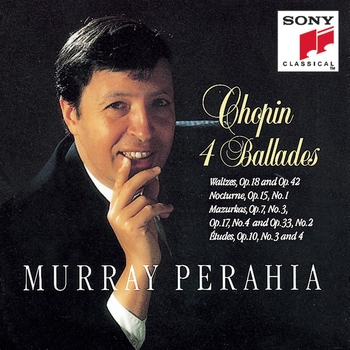
Four Ballades. Mazurkas. Waltzes. Etudes. Nocturne No 4
Murray Perahia pf
(Sony Classical)
This is surely among the greatest of Perahia’s many exemplary recordings. Once again his performances are graced with rare and classic attributes and now, to supreme clarity, tonal elegance and musical perspective, he adds an even stronger poetic profile, a surer sense of the inflammatory rhetoric underpinning Chopin’s surface equilibrium. In other words the vividness and immediacy are as remarkable as the finesse. And here, arguably, is the oblique but telling influence of Horowitz whom Perahia befriended during the last months of the old wizard’s life. Listen to the First Ballade’s second subject and you’ll hear rubato like the most subtle pulsing or musical breathing. Try the opening of the Third and you’ll note an ideal poise and lucidity, something rarely achieved in these outwardly insouciant pages. From Perahia the waltzesare marvels of liquid brilliance and urbanity. Even Lipatti hardly achieved such an enchanting lilt or buoyancy, such a beguiling sense of light and shade. In the mazurkas, too, Perahia’s tiptoe delicacy and tonal iridescence (particularly in Op 7 No 3 in F minor) make the music dance and spin as if caught in some magical hallucinatory haze. Finally, two contrasting Etudes, and whether in ardent lyricism (Op 10 No 3) or shot-from-guns virtuosity (Op 10 No 4), Perahia’s playing is sheer perfection. The recording beautifully captures his instantly recognisable, glistening sound world.
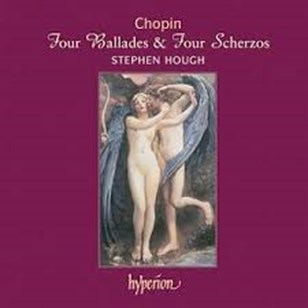
Four Ballades. Four Scherzos
Stephen Hough pf
(Hyperion)
This is astonishing piano playing; Chopin interpretation that, at its best, fully measures up to the greatness of these pieces. Stephen Hough’s accounts offer plenty of refreshment to spirit and senses.
The distribution is interesting, chronological but alternating one of each, which may not make a recital to consume at one go but helps to point up these pieces’ diversity and individual character, as well as Chopin’s mastery of large forms. Hough is unfailingly thoughtful; there isn’t a note that hasn’t been cared for.
Just a few of them (Third Ballade, for example) are picked out of the texture and strung together for our delectation in a way that might strike you as otiose if you’re in a sober-sides kind of mood. The surfaces of his presentations are very ‘worked’, more indicative of application, maybe, than of organic growth. But this isn’t superficial playing – the performances catch fire.
He inclines to the accepted view that Chopin’s large forms have a ‘plot’ that culminates in a tumult or a whirlwind of activity. The tempest in the coda of the Fourth Ballade might have been a mite less furious, to let the ear have more time to register what’s going on. The closing pages of No 1, on the other hand, have an exemplary finish and allure. Most distinguished of the Ballades is No 2, where Hough perceives the invasion of one kind of music by another in all its subtlety and lays out a spellbinding seven-minute drama.
He has interesting points to make in the Scherzos, too. Where many a player is content to let recurring sections and paragraphs register simply as the music we heard before, with him they sound different in some degree, affected by what’s come in between. Hough is always doing something, though sometimes you might wish he were doing less. This is an issue out of the ordinary; welcome, too, for being handsomely recorded and produced.
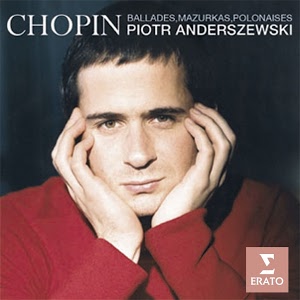
Ballades Nos 3 & 4. Mazurkas. Polonaises Nos 5 & 6
Piotr Anderszewski pf
(Erato)
Following his celebrated earlier discs of Beethoven, Mozart and Bach, 34-year-old Piotr Anderszewski gives us an exceptionally powerful and seductive Chopin recital. He prefers a subtly chosen programme to complete sets of the Mazurkas, Ballades or Polonaises, and his often phenomenally acute and sensitive awareness of Chopin’s constantly shifting perspective has you reliving every bar of such incomparable music.
In the three Op 59 Mazurkas (a notably rich part of Chopin’s deeply confessional diary) he achieves a rare sense of brooding introspection, close to neurosis, with bittersweet mood-swings that shift from resignation to flashes of anger. Then there’s the F minor Mazurka, Op 63 No 2, taken for once at a true lento, a dark place indeed for Anderszewski, with only relative light in the central idea to lessen the mood of heart-stopping despondency. Again, in both the Ballades his sharply original ideas combine with a total responsibility to the score; seldom can the letter and spirit of the composer be united so flawlessly.
Eyebrows may be raised in the A flat Polonaise but this is no obvious celebration of triumph over adversity, rather a re-creation of music which lives again in all its initial audacity. Here, in this great young pianist’s incomparable hands, and in Erato’s excellent sound, is living proof that Chopin’s music is forever new, forever revelatory.
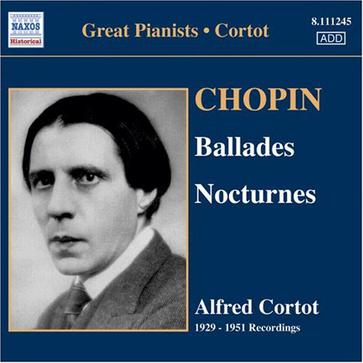
Four Ballades. Nocturnes
Alfred Cortot pf
(Naxos Historical mono)
From HMV originals, recorded 1929-51
This fifth and final release of Cortot’s 78rpm Chopin recordings is surely the jewel in the crown. Here, the 1929 rather than the more familiar 1933 set of the Ballades blazes with a passion, brilliance and poetic audacity that set the pulse racing and the mind reeling. Here is a great artist who seized the opportunity to achieve ever greater heights of eloquence and rhetorical verve. Superbly restored by Mark Obert-Thorn, every performance is charged with a heady and consuming poetry that confirms Daniel Barenboim’s claim that ‘Cortot discovered the opium in Chopin’. Take the First Ballade’s opening, where Cortot is every inch the bardic poet, free, rhapsodic and inimitable; or hear him in the Presto con fuoco storms of the Second Ballade, where he plays as if pursued by the furies of hell.
Again, even when inaccuracies fly in all directions in the heat of the chase, no other pianist has approached the Third Ballade’s central C sharp minor turbulence with such daring or recreative force. Cortot was never one to hold back in the interests of decorum and in the Fourth Ballade he stretches the parameters of Chopin’s poetry to the very edge, his playing close to being consumed in its own ecstasy.
His selection of Nocturnes (sadly his projected Chopin survey was never completed) pulse with the same alluring quality, suggesting the reverse of Rubinstein’s more patrician elegance. True, for today’s more antiseptic and ‘tasteful’ practitioners such artistic conviction and originality will seem extravagant or even camp. Yet there is surely no living pianist who could or would attempt to emulate such heart-stopping poetry. Maria Callas herself would have been among the first to pay tribute to Cortot’s cantabile, an unequalled ‘singing’ at the piano.
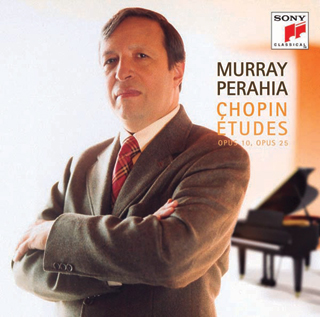
Etudes
Murray Perahia pf
(Sony Classical)
Perahia brings order and lucidity to the heart of Chopin’s most audacious fire-storms and in, for example, Etudes Nos 1 and 4 from Op 10, you’re made aware of an incomparable mix of poetry and precision. Perahia’s may be a wholly modern voice yet he truly speaks in the spirit of his revered masters of the past, of Cortot and Fischer in particular, and this, allied with his immaculate, infinitely polished and shaded pianism, gives his performances the rarest distinction and quality.
How superb and unfaltering is his mastery in No 1, that magnificent curtain-raiser to Op 10, how magical his improvisatory touch in its closing page. His textural translucency and musical breathing, hisrubato in No 3, like that of Rubinstein, is that of a great and natural singer of the keyboard. Chopin would surely have cried out once again, ‘ah, mon patrie!’ if he had heard this performance.
No 8 is delightfully rumbustious, and just when you note a touch of evasion in his rapid spin through the morbid near-Wagnerian chromaticism of No 6 you find yourself relishing his cool tempo, a musical ease and flexibility that give new meaning to Chopin’s prescribed con molto espressione. On the other hand No 7 from Op 25 unfolds with the truest, most memorable sense of its lento elegy. And where else have you heard a more impassioned or articulate Revolutionary Etude? Perahia’s is the finest of all modern discs of the Etudes, and Sony’s sound captures all his artistry.
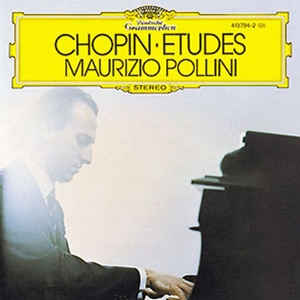
Etudes
Maurizio Pollini pf
(DG)
Recorded 1972
The 24 Etudes of Chopin’s Opp 10 and 25, although dating from his twenties, remain among the most perfect specimens of the genre ever known, with all technical challenges – and they are formidable – dissolved into the purest poetry. With his own transcendental technique (and there are few living pianists who can rival it), Pollini makes you unaware that problems even exist – as for instance in Op 10 No 10 in A flat, where the listener is swept along in an effortless stream of melody. The first and last of the same set in C major and C minor have an imperious strength and drive; likewise the last three impassioned outpourings of Op 25.
Lifelong dislike of a heart worn on the sleeve makes him less than intimately confiding in more personal contexts such as No 3 in E major and No 6 in E flat minor from Op 10, or the nostalgic middle section of No 5 in E minor and the searing No 7 in C sharp minor from Op 25. Like the playing, so the recording itself could profitably be a little warmer at times, but it’s a princely disc all the same.
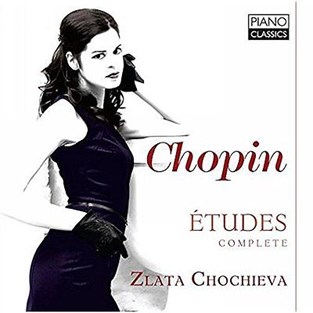
Etudes
Zlata Chochieva pf
(Piano Classics)
A famous pianist (I shan’t say who) to whom I was speaking recently said I really should hear this young Russian pianist Zlata Chochieva in the Chopin Etudes. ‘It is,’ averred my informant, ‘the greatest I’ve ever heard.’ Quite a claim.
I’ve now listened to this disc several times and all I can say is that in each of the 27 studies Chochieva comes as close as anyone to how I hear the ideal performance in my head, or as I would wish to play them had I the ability to do so. Right from the opening C major study, as in many others, she finds some extramusical narrative beyond the text that I find profoundly moving. Taken as read are a superlative technique and an ideal recorded sound (from engineer Peter Arts). No details are overlooked yet without drawing undue attention to them: note the staccato markings of the A minor study (richly voiced by Chochieva, the left hand sounds almost like a plucked string bass) and also in the second subject of No 3, a good example of the meltingly lovely tone Chochieva produces. No 4, so often tossed off as a finger sprint (Richter, Cziffra), is given room to breathe while still being played presto and con fuoco.
I could go on picking out highlights from each study – the question-and-answer voicing in No 9, the subtle rubato in Op 25 No 1, the infamous studies in thirds and sixths in which, simultaneously, Chochieva reminds us of Chopin the contrapuntalist – moments and passages which made me listen afresh to these familiar works and, in some cases, hear things of which I had been previously unaware. The greatest on disc? I don’t know; but it is certainly one of the most consistently inspired, masterfully executed and beautiful-sounding versions I can recall.
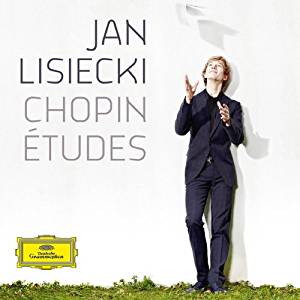
Etudes
Jan Lisiecki pf
(DG)
When, if ever, have you heard the Chopin Etudes played as pure music, given as naturally as breathing yet recreated from an entirely novel perspective? From Jan Lisiecki, Chopin’s poetic essence, hidden beneath every thorny, relentlessly focused problem, emerges with an inimitable subtlety and elegance. Lisiecki gives us tone-poems first and studies second, his technique as unobtrusive as it is effortlessly fluent, lissom and precise. Take Op 10 No 1, from Lisiecki a grand maestoso curtain-raiser that transcends a more familiar and determinedly virtuoso rush. No 4 is brilliantly articulate rather than manic or blistering (re Cziffra and, it has to be said, Richter and Argerich). What quiet, scintillating charm in No 5 (the ‘black keys’ etude), what intuition in the agitated short-long-short phrases of No 9.
Rarely have I heard a more assured left hand in the cadenzas or flourishes of Op 25 No 7 (and this within the context of a magically confided reading). No 8 (sixths) is playful and giocoso, while in No 10 (octaves) Lisiecki shows himself no stranger to strength and drama when Chopin is in his stormiest B minor mood. Yet overall it is the luminous quality of his musicianship that strikes you at every turn. DG has struck gold and I can only hope that such a perceptive, natural and unforced talent will remain untarnished by commercial pressures. Never for a moment would I want to be without celebrated recordings by Cortot, early Pollini and Ashkenazy and Perahia, but for a memorable musical recreation Lisiecki stands alone.
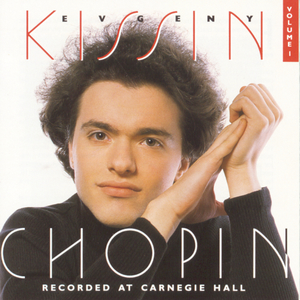
Fantasie, Op 49. Waltzes. Polonaise No 5. Nocturnes. Scherzo No 2, Op 31
Evgeny Kissin pf
(RCA Victor Red Seal)
Recorded live 1993
Evgeny Kissin’s playing at 21 (when these performances were recorded) quite easily outmatches that of the young Ashkenazy and Pollini – most particularly in terms of the maturity of his musicianship. The programme launches with a reading of the great F minor Fantasie, which, though a bit measured, is integrated to perfection. The power and determination of the performance certainly make one sit up and listen, but at the same time it would be difficult not to be moved by the heartfelt lyricism of the melodic passages. Although Kissin may be a little unsmiling in the three Waltzes, at least he has admirable sophistication in being able to add interest to the interpretations. His control in the tricky A flat, Op 42, is quite amazing. The Nocturnein C sharp minor is a jewel. This reading is among the most darkly imaginative and pianistically refined on disc. The disc ends with a powerfully glittering performance of the Second Scherzo.
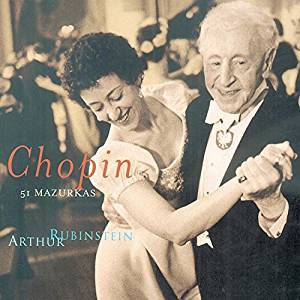
Mazurkas Nos 1-51
Arthur Rubinstein pf
(RCA Victor Red Seal)
Recorded in the 1960s
Recording in the studio, rather than at a live concert, quite naturally leads to a safe and uniform approach, which doesn’t really serve the inspired inventiveness of the music. In some ways these recordings suffer from this. If you compare Rubinstein’s readings here with those he recorded on 78rpm discs in 1938-39, you immediately notice that an element of fantasy and caprice has given way to a more sober view of the music. The Mazurkas are so intricate in their variety of moods that the successful pianist has to be able to treat each one as an entity, contrasting the emotional content within the context of that particular piece. Rubinstein, with his serious approach, lends the music more weight than is usual and he wholly avoids trivialising it with over-snappy rhythms. With him many of the lesser-known Mazurkas come to life, such as the E flat minor, Op 6 No 4, with its insistent little motif that pervades the whole piece. His phrasing is free and flexible and he has utter appreciation of the delicacy of Chopin’s ideas. He doesn’t, however, take an improvisatory approach. Rubinstein judges to perfection which details to bring out so as to give each piece a special character. He convinces one that he has made this music his own. When you hear Rubinstein tackle the C sharp minor Mazurka, Op 53 No 3, you at once know that he fully comprehends the depth of this, perhaps the greatest of them all. He ranges from the pathos of the opening to a persuasive tonal grandeur in the more assertive parts, and yet is able to relate the two. The recording has a number of blemishes: the piano is too closely recorded, the loud passages are hollow-toned, especially in the bass, and there is little sparkle to the sound.
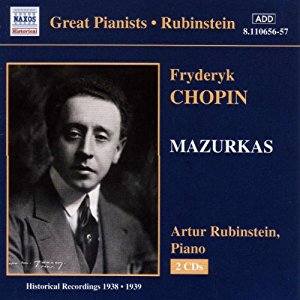
Mazurkas Nos 1-51. Waltzes
Arthur Rubinstein pf
(Naxos Historical mono – 8 110656/7)
Nocturnes, Nos 1-19. Four Scherzos
Arthur Rubinstein pf
(Naxos Historical mono – 8 110659/60)
It’s controversial to say so, but such playing makes a mockery of present-day standards. All these performances prove that Rubinstein played the piano as naturally as a bird flies or a fish swims. He was simply in his element, and never more so than in Chopin. Who else has given us the Nocturnes with such ravishing inwardness, pianistic sheen and a bel canto to rival the finest singer? Decorative fioritureare spun off like so much silk, and whether or not you consider Op 15 No 2 ‘inseparable from champagne and truffles’ and Op 27 No 1 a portrait of ‘a corpse washed ashore on a Venetian lagoon’, or hear the nightingales of Nohant in Op 62 No 1 and the chant of the monks of Valdemosa in Op 15 No 3 and Op 37 No 1, you can hardly remain unaffected by Rubinstein’s unique artistry. His feline ease in the double-note flow of Op 37 No 2, or the way he lightens the darkness of the great C minor Nocturne without losing an ounce of its tragedy, all form part of the genius that made him the most celebrated of all Chopin pianists.
Rubinstein’s Mazurkas are equally the stuff of legends. Chopin’s most subtle and confessional diary, they transcend their humble origins and become in Rubinstein’s hands an ever-audacious series of miniatures extending from the neurasthenic to the radiant, from Chopin’s nagging child (Op 17 No 3) to the unfurling of proud ceremonial colours (Opp 63 No 1). What heartache he conveys in Op 63 No 3; and when has Op 67 No 3 been more intimately confided, its banal association with Les sylphides more blissfully resolved? Chopin’s final composition, Op 68 No 4, becomes a valediction encouraging rather than forbidding weeping, Rubinstein’s rubato the caressing magic that created a furore at his unforgettable recitals.
Finally the Scherzos, played with an outrageous but enthralling disregard for safety. Only a pedant will underline the odd mis-hit or pock-mark in the context of such sky-rocketing bravura and poetic impulse. As an added bonus there are additional recordings of three Mazurkas and two Waltzes, the A flat Op 34 No 1 alive with dizzying virtuoso trickery. The booklet-note writer may comically mistake the Mazurkas for the Polonaises in referring to Schumann’s oft-misquoted description, ‘guns [sic] buried in flowers’, but that’s a mere spot on Naxos’s blazing sun. No more life-affirming Chopin exists.
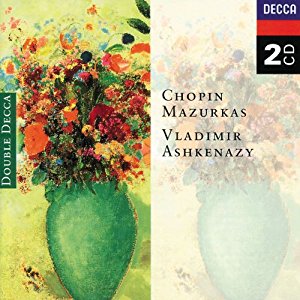
Mazurkas Nos 1-52, 55, 56, 59-62
Vladimir Ashkenazy pf
(Double Decca)
Recorded 1976-85
Vladimir Ashkenazy made his integral set of the Mazurkas over a decade. He has always played outstandingly. He does so again here, giving complete satisfaction. The set includes all those published posthumously and the revised version of Op 68 No 4, so this is a comprehensive survey. Ashkenazy memorably catches their volatile character, and their essential sadness. Consider, for example, the delicacy and untrammelled spontaneity with which he approaches these works. He shows the most exquisite sensibility, each item strongly though never insistently characterised. His accounts of the Mazurkas of Opp 6 and 7, for instance, offer a genuine alternative to Rubinstein. Nine pieces in all, they were Chopin’s first published sets and their piquancy, the richness of their ideas, is here made very apparent. One is given a sense of something completely new having entered music. Although there are fine things in all the groups, Op 24 is the first Mazurka set of uniformly high quality and No 4 is Chopin’s first great work in the genre.
On hearing them together like this one appreciates the cumulative effect which the composer intended, and Ashkenazy makes a hyper-sensitive response to their quickly changing moods. The recorded sound has the warmth, fullness and immediacy typical of this series, with a nice bloom to the piano tone.
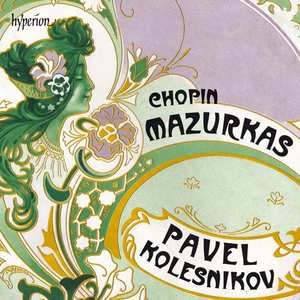
Mazurkas
Pavel Kolesnikov pf
(Hyperion)
Chopin is far and away the most popular among his coevals, Mendelssohn, Schumann and Liszt, and much of his music is within the grasp of amateur pianists. Responses to him are so deeply and inevitably personal that, in a way, the Mazurkas, Chopin’s preferred dance form, belong to everyone, whether they first experienced them listening to performances or recordings by Rubinstein or Pollini, watching choreography of Fokine or Robbins, or through their own hands. Personally speaking, I don’t recall not recognising at least a couple of mazurkas. All the more astonishing, then, to encounter in Pavel Kolesnikov’s new disc an ideal realisation of these exquisite dances, the likes of which I never dreamt of hearing.
Three sets (Opp 17, 24 and 50) are given complete. But Kolesnikov doesn’t present his thoughtful selection of 24 dances in tedious chronological order. As befits a dazzling bouquet, each blossom is given unique placement for maximum enjoyment of colour and fragrance.
It is Chopin’s dogged repetitions that can lead the mazurka’s most admiring votaries into desperate straits of rhythmic grotesquery. Kolesnikov takes these repetitions at face value, as integral to Chopin’s expressive intent. In his scrupulous observation of all repeats, he seems to revel in endlessly varying them without resort to distorting rubato. Not that Kolesnikov lacks pliancy. Liszt said it: ‘A wind plays in the leaves, life unfolds and develops beneath them, but the tree remains the same – that is the Chopin rubato.’ Kolesnikov does it.
Some of the larger set pieces, Op 59 No 3, Op 24 No 4 or Op 50 No 1, for instance, come to life almost cinematically. One easily imagines a large drawing room cleared of furniture and rugs, its floors swept clean and sprinkled in preparation for a dozen couples whose dancing skill is a joy to behold. The largest of these, Op 50 No 1, unfolds with great affective variety and richly varied sonorities, its tragic utterance chaste, courageous, the whole as tight as the snug fit of a master joiner.
Others speak with seductive charm. The poise of Op 17 No 2 is maintained without a trace of maudlin sentimentality. The rhythmic vitality of Op 33 No 1 keeps any suggestion of morose indulgence at bay. The strikingly different characters of Op 33 No 3, ingratiating, delicate, and the sensual melancholy of Op 68 No 2 share a sense of confiding intimacy. The stuttering rhetoric and gossamer fioritura of Op 17 No 4 are a nocturne in all but name.
The Warsaw Mazurkas are a world unto themselves. KK IIa/3, perhaps the earliest, is lithe and spry with the unselfconsciousness of youth. In the hushed sensuality of KK IIb/5, octaves in the middle contrasting section evoke silver bells, while the trills at the end grip the heart. KK IIb/4 in particular embodies Kolesnikov’s ability to choose the perfect sonorities that seem to instantly encapsulate the character of the music.
There are some mazurkas, such as Op 24 No 3, when an inexplicable kinesthetic magic takes over and the world’s rotation all but stops. Prone to lose its way in rhetorical excess, Op 30 No 2 here remains shapely, proportionate. In the familiar Op 6 No 1, the contrasting middle section borders on the terrifying. The implacable tragedy of Op 56 No 3 is so pervasive, you may find yourself, as I did, clinging to the contrasting middle section as though to a life raft.
I know of no other pianist who combines attention to the smallest detail with such nobility of phrase and cohesive sweep of the dance as a whole. The engineers have captured Kolesnikov’s sound – silvery, deeply resonant – perfectly. Listening to this recording over a period of weeks, Wagner’s description of Beethoven’s Seventh Symphony as ‘the apotheosis of the dance’ kept running through my mind. Whether or not Kolesnikov’s new disc will suggest to everyone ‘the apotheosis of the mazurka’, for me these performances are the most beautiful and strikingly original I’ve heard.
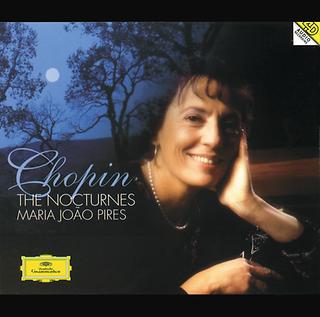
Nocturnes
Maria João Pires pf
(DG)
Passion rather than insouciance is Pires’s keynote. Here is an intensity and drama that scorn all complacent salon or drawing-room expectations. How she relishes Chopin’s central storms, creating a vivid and spectacular yet unhistrionic contrast with all surrounding serenity or ‘embalmed darkness’. The con fuoco of Op 15 No 1 erupts in a fine fury and in the first Nocturne, Op 9 No 1, Pires’s sharp observance of Chopin’s appassionato marking comes like a prophecy of the coda’s sudden blaze. Chopin, she informs us in no uncertain terms, was no sentimentalist. More intimately, in Op 15 No 3 (where the music’s wavering sense of irresolution led to the sobriquet ‘the Hamlet Nocturne’) Pires makes you hang on to every note in the coda’s curious, echoing chimes, and in the dolcissimo conclusion to No 8 (Op 27 No 2) there’s an unforgettable sense of ‘all passion spent’, of gradually ebbing emotion. Pires with her burning clarity has reinforced our sense of Chopin’s stature and created a new range of possibilities (showing us that there’s life after Rubinstein). Naturally, Rubinstein’s legendary cycles possess a graciousness, an ease and elegance reflecting, perhaps, a long-vanished Belle Epoque. Yet moving ahead, one has no hesitation in declaring Maria João Pires among the most eloquent master-musicians of our time.
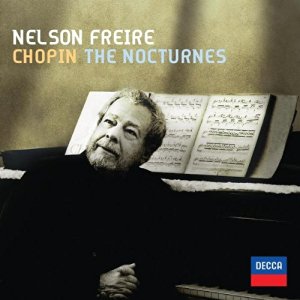
Nocturnes
Nelson Freire pf
(Decca)
For Freire the Nocturnes are tirelessly experimental, an opalescent world of shifting moods and colours. Too serious to be overtly glamorous or heart-stopping, his warm-hearted performances eschew a concert-hall brio in favour of intimacy, almost as if played in the privacy of one’s own room. Not that he is immune to those sudden flashes of anger never far from Chopin’s always volatile nature. He is dramatically alive to the startling end to the Field-like B major Nocturne, Op 32 No 1, with its muffled timpani strokes and a sudden, chilling menace. The posthumous E minor Nocturne, too, which, as the booklet-notes usefully tell us, is a late rather than early work, emerges pained and drawn, reminding you of Delacroix’s celebrated portrait of Chopin. But overall Freire is at his finest in readings which are pensive and conciliatory. He is truly lento in the G minor Nocturne with its obsessive questioning and religioso conclusion, and time and again he makes you see these works as truly night pieces, music of an ‘embalmed darkness’ (to quote Keats). True, there are moments when a once legendary and impeccable technique stiffens (in the double-note flow of the G major Nocturne), yet this is less than marginal in music-making so personal and reflective.
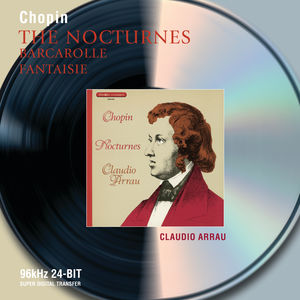
Nocturnes. Barcarolle. Fantasia in F minor
Claudio Arrau pf
(Philips)
In his published conversations with Joseph Horowitz, Claudio Arrau startled his interviewer by claiming Chopin's greatest achievement to be the Nocturnes. In any event, Arrau's Nocturnes are likely the greatest achievement among his Chopin recordings. Why was Arrau so important in this music? Not to put too fine a point on it, he helped rescue Chopin from the pianists. On this 1977 recording there are no concert-hall roulades or frills - or lace, to use Arrau's own put-down of pianists who are nimbler of finger than of brain. He only offers the music - distilled and deeply pondered, and voiced and balanced with superhuman clarity. He is devastatingly honest without being showy. Tempi are slow enough for musical points to breathe: emotion is recollected in tranquillity, to borrow Wordsworth's definition of poetry. There's no falseness or smoothing-over of detail. It hardly matters that Arrau disrupts the lyricism of some pieces (Op 15 No 1). Sporting masterly control and a dark tone of infinite depth, he goes beyond lyricism to give every note its own inflection, its own colour. Joseph Horowitz points out Arrau's ability to play the Nocturnes' many ornaments as intrinsic parts of the melodic line. It's a kind of thorough textural organicism – to every note its place - that Beethoven or Schoenberg would have envied. And it's just the performance to show just how far the Nocturnes are from being mere character pieces – the slight, Romantic keyboard comfits that allowed the word 'bagatelle' to become a pejorative. As Schoenberg said of Webern's music, so one could say of Chopin's Nocturnes when Arrau plays them: 'a glance can be spun out into a poem, a sigh into a novel'.
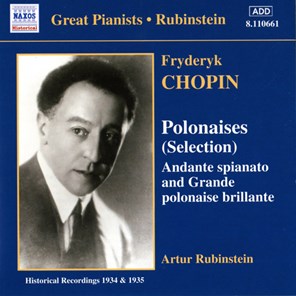
Polonaises Nos 1-7. Andante spianato and Grande polonaise, Op 22
Arthur Rubinstein pf
(Naxos Historical mono)
Recorded 1934-35
Here, in all their glory, are Rubinstein’s 1934-35 recordings of Chopin’s six mature Polonaises framed by examples of his early and late genius (Opp 22 and 61 respectively). Together with his early discs of the Mazurkas, Scherzos and Nocturnes, these performances remain classics of an unassailable calibre, their richness and character increased rather than diminished by the passage of time.
For Schumann, the Polonaises were ‘cannons buried in flowers’ and whether epic or confiding, stark or florid, their national and personal fervour is realised to perfection by Rubinstein. Listen to the Andante spianato from Op 22 and you’ll hear a matchless cantabile, a tribute to a bel canto so often at the heart of Chopin’s elusive and heroic genius. Try the central meno mosso from the First Polonaise and witness an imaginative freedom that can make all possible rivals sound stiff and ungainly by comparison. The colours of the A major Polonaise are unfurled with a rare sense of its ceremonial nature, and the darker, indeed tragic, character of its sombre C minor companion is no less surely caught. The two ‘big’ Polonaises, Opp 44 and 53, are offered with a fearless bravura (you can almost hear the audience’s uproar after Rubinstein’s thunderous conclusion to the latter), rhythmic impetus and idiomatic command beyond criticism.
The simple truth is that Rubinstein played the piano as a fish swims in water, free to phrase and inflect with a magic peculiarly his own, to make, in Liszt’s words, ‘emotion speak, weep and sing and sigh’. The sound may seem dated but Naxos’s transfers are excellent, and to think that all this is offered at super-budget price…
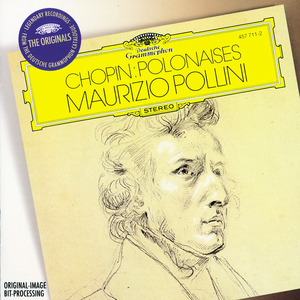
Polonaises Nos 1-7
Maurizio Pollini pf
(DG)
Recorded 1975
This is Pollini in all his early glory, in expertly transferred performances. Shorn of all virtuoso compromise or indulgence, the majestic force of his command is indissolubly integrated with the seriousness of his heroic impulse. Rarely will you be compelled into such awareness of the underlying malaise beneath the outward and nationalist defiance of the Polonaises. The tension and menace at the start of No 2 are almost palpable, its storming and disconsolate continuation made a true mirror of Poland’s clouded history. The C minor Polonaise’s denouement, too, emerges with a chilling sense of finality, and Pollini’s way with the pounding audacity commencing at 3'00" in the epic F sharp minor Polonaise is like some ruthless prophecy of every percussive, anti-lyrical gesture to come. At 7'59" Chopin’s flame-throwing interjections are volcanic, and if there’s ample poetic delicacy and compensation (notably in the Polonaise-fantaisie, always among Chopin’s most profoundly speculative masterpieces), it’s the more elemental side of his genius, his ‘cannons’ rather than ‘flowers’ that are made to sear and haunt the memory. Other pianists may be more outwardly beguiling, but Pollini’s magnificently unsettling Chopin can be as imperious and unarguable as any on record. That his performances are also deeply moving is a tribute to his unique status.
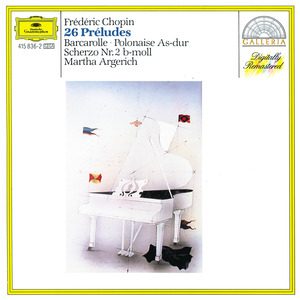
Preludes Nos 1-26. Barcarolle, Op 60. Polonaise No 6. Scherzo No 2
Martha Argerich pf
(DG)
Jerzy Żurawlew, the founder of the Chopin Competition in Warsaw, was once asked which one of the prize-winners he would pick as having been his favourite. The answer came back immediately: Martha Argerich. This disc could explain why. There are very few recordings of the 24 Preludes that have such a perfect combination of temperamental virtuosity and compelling artistic insight. Argerich has the technical equipment to do whatever she wishes with the music. Whether it’s in the haunting, dark melancholy of No 2 in A minor or the lightning turmoil of No 16 in B flat minor, she’s profoundly impressive. It’s these sharp changes of mood that make her performance scintillatingly unpredictable. In the Barcarolle there’s no relaxed base on which the melodies of the right hand are constructed, as is conventional, but more the piece emerges as a stormy odyssey through life, with moments of visionary awareness. Argerich is on firmer ground in the Polonaise, where her power and technical security reign triumphant. The CD ends with a rippling and yet slightly aggressive reading of the Second Scherzo. This is very much the playing of a pianist who lives in the ‘fast lane’ of life. The sound quality is a bit reverberant, an effect heightened by the fact that Argerich has a tendency to overpedal.

Preludes. Mazurkas Nos 41 & 47
Grigory Sokolov pf
(DG)
Good news for pianophiles everywhere that Grigory Sokolov has, as DG put it, now signed an exclusive contract. This is of course not taking him into the studio or anything as workaday as that. No, he has allowed them to release a live recital from the 2008 Salzburg Festival. But let’s not knock that: it’s difficult to imagine just how much negotiation that must have taken. Comparisons are irrelevant (except perhaps with himself): this is Sokolov we’re talking about. But in this cult of celebrity, his very aversion to the notion has turned him into one – a bit like Glenn Gould in an earlier era.
Of course, all of this would be beside the point if he didn’t produce the goods. It’s an overused word, but he is inimitable. His Chopin Preludes, for example, have no time for the notion of a freely Romantic melodic line being kept in check by a Classical accompaniment. Sokolov’s reading as a whole is remarkably consistent with that of his live 1990 recital released on Opus 111. In both, he begins unhurriedly, as if the music were gently rousing itself into life. But whereas in less imaginative hands the results could seem mannered or overly drawn out, here it’s mesmerising. In the Sixth Prelude, for instance, the upward curling arpeggio has a rare poignancy, while the Tenth glistens but also has an unexpected hesitancy about it. In No 13, the glorious melody of the middle section is given with a freedom that would simply not work in a lesser musician; while in the infamous ‘Raindrop’, Sokolov replaces the constant dripping with a shifting pulse that has a real urgency, albeit an unconventional one. No 19 is a particular highlight, its delicacy quite heart-stopping. He ends as he began, with a tempo for No 24 that has gravitas (not to be confused with heaviness), the effect granitic, magisterial.
The Mozart is treasurable too, though – of course – you have to take it on its own terms. What he does with the slow movement of K280, for instance, gives it a kind of operatic reach and breadth, though never does it lapse into histrionics. And in the finale he brings out the main theme’s stuttering quality superbly, lending the music not just a mercurial quality but a dramatic one too. His delight in the chewy harmonies of the opening movement of K332 is palpable, his phrasing iridescent in its range.
The Salzburg audience (who are generally reasonably silent except for the tumultuous applause) were lucky enough to get six encores. The Scriabin Poèmes are more than usually clear descendants of Chopin in Sokolov’s hands and the filigree is out of this world. By contrast, Rameau’s Les Sauvages is unexpectedly playful and whimsical, and we end with a clear-sighted Bach chorale prelude that is all the more moving for its apparent simplicity. As Sokolov says in the booklet: ‘I play only what I want to play at the current moment.’ Perhaps that’s what gives this set such integrity.
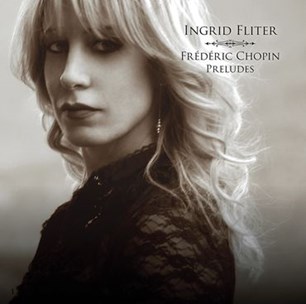
Preludes. Mazurkas. Nocturnes
Igrid Fliter pf
(Linn)
It says a lot for this disc that, when Gramophone’s Editor chose it as his Recording of the Month and asked me for five listening points, I came up with nearly four times that number. No single interpretation of Chopin’s Preludes will ever be enough but – just as she demonstrated in her previous disc of the two Chopin concertos (3/14) – the Argentinian Ingrid Fliter seems to be able to achieve individuality seemingly effortlessly, with cherishable and memorable results.
Truly innate Chopin players are rarer than you might think. From obvious examples such as Rubinstein and Cortot via Argerich and Freire (what is it with these South Americans?) I would add to that illustrious list Fliter. She has that magical way of creating an easeful rubato without ever sounding studied, and holds Classicism and freedom in perfect accord. Add to that a clarity of vision and a tremendous sense of purpose and you have a mesmerising set of Preludes. She doesn’t ever sweeten the more acerbic moments: in the Second Prelude, for instance, she makes no attempt to soften the contours of the left-hand phrases in the manner of pianists such as Trifonov, who is altogether more consoling here. And in No 4 Fliter lays bare with utter naturalness the insistent falling semitone, forming a piquant contrast with the following Prelude, in which she gives Cortot a run for his money in terms of shimmery, shadowy elusiveness. In Fliter’s readings you truly feel the complexity and ambiguity of works once described by Schumann as ‘sketches, beginnings of études…ruins…all disorder and wild confusion’.
One of the aspects that particularly compels about this CD on repeated listening is the way Fliter encompasses the diversity, the sometimes shocking juxtaposition of the Preludes, but within a range that gives them a coherence, a sense of an interpretation as a whole. Take Nos 6 and 7, for instance: here they acquire a kinship despite their different moods – and despite the fact that No 6 is pretty slow, possibly too slow for some tastes. But I find myself hypnotised rather than (perish the thought!) bored: contrast it with Kissin’s approach, which ruffles the melody rather too insistently. Then compare her with Trifonov, whose live Preludes from Carnegie Hall provide a thrill a minute but who seems altogether too fast here. In fact he isn’t by most standards: it’s simply that Fliter draws so much from the music.
It’s not just in slower preludes that Fliter flouts received wisdom (something she did so gloriously in the concertos, scotching the notion, aided and abetted by Jun Märkl’s charismatic way with the Scottish Chamber Orchestra, that these are little more than a pianistic vehicle); she does it too in the 16th Prelude, where the étude-like moto perpetuo of the right hand is effortless but suitably ‘notey’ thanks to her pinpoint phrasing, while the muscular left hand gains in power rather than steamrollering its way in, as can happen in some readings (Kissin, for instance, who is relentless in his strength). By comparison, Trifonov is faster but he doesn’t develop such a sense of menace as Fliter.
After this, the songful Allegretto of No 17 comes as balm, here given the range and story-telling quality of a Ballade. It starts innocently enough; but what is striking is the way she grounds it with the deep left-hand notes, the repeated A flat at the end tolling like some great bell but never overshadowing the interplay of the other lines, which Fliter balances to perfection.
She is a virtuoso of the first order but she holds this in reserve, so when she does unleash her full technical armoury, it’s extraordinarily potent. She does so in No 14, for instance, matching Trifonov in powerful élan. On the other hand, the 19th Prelude eschews its Vivace marking. It’s daringly dreamy, perhaps too much so for some tastes but not mine. The final trio of preludes takes us from the proto-Prokofievian toccata figuration of No 22 via the most restrained haloed playing in the daringly withdrawn F major, Fliter really bringing across its tinkling musical-box qualities, which is all the more touching when it is banished by the seismic drama of the final Prelude.
Of the remaining works, the two Nocturnes are particularly fine, the Mazurkas sometimes a degree less inevitable-sounding than some, though she bewitches in the quick-shifting moods of Op 6 No 1, which prefaces the third Op 9 Nocturne very effectively. The final Nocturne on the disc (Op 27 No 2) takes nothing for granted in spite of its fame, less lushly beautiful than some but altogether more complex, more intriguing. The recording captures well Fliter’s innate beauty of sound, encompassing the dynamic range with ease. A gem of a disc.
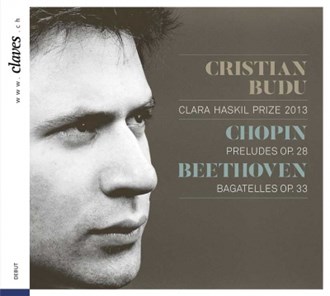
Preludes
Cristian Budu pf
(Claves)
Listening to his impressive new recording, it’s easy to understand why Cristian Budu won the Clara Haskil Competition in Vevey three years ago this September. A Brazilian of Romanian descent who studied at the University of São Paulo and the New England Conservatory, Budu is a stunningly original pianist with musical insight and maturity that could inspire envy in colleagues twice his age. He has the sort of hands that used to be called ‘velvet paws’, which are seemingly incapable of making an ugly sound at the instrument. Online videos show him to be strictly business. No demonstrations of how almost to fall off the bench, no stomping the floor, no challenging Lon Chaney for the title ‘Man of a Thousand Faces’. Completely relaxed but with an almost scary intensity of focus, Budu’s every motion is directed towards the production of sound. All this comes through loud and clear via the strictly audio medium of the CD, captured with remarkable nuance by the Claves engineers.
For his debut recording, Budu chooses an entire disc of miniatures. He is able to focus attention on the tiniest details while leaving proportions perfectly intact. Eloquent phrasing is ever front and centre, and no expressive potential is left unexplored. He commands an immense colour palette and moves from a robust fortissimo to a scarcely audible pianissimo in a nanosecond.
It’s a credit to the subtlety of Budu’s musicianship to say that his Op 33 Beethoven Bagatelles could easily be transferred to an 1804 Streicher with barely an adjustment of the touch he uses on the modern Steinway. Scrupulously observant of the composer’s agogic indications, the abundant drolleries of these pieces are understated and all the wittier for it. My favourite is the C major (No 5), which scurries about with amazingly precise urgency. When all the coruscating bustle finally runs up against a solid wall, Budu resists violent assault, the default choice of most pianists. Instead, he recovers from his bewilderment and, to great comic effect, seems to fashion a door, and calmly walk through.
Were his Chopin Preludes not so delicately coloured, their visual equivalent might be leafing through a portfolio of Ingres’s finest graphite portraits, marvelling at their succinct precision and lifelike directness. At once their striking individuality embraces a sweep and cohesion that leave the impression that the entire set could have been captured in a single take. The A minor (No 2) demonstrates Budu’s ability to create a heart-gripping pianissimo, whispered and just barely audible. In the G major (No 3), the right hand floats spacious and serene over the bubbling cascade of left-hand figuration. The A major (No 7) is a genuine Mazurka in microcosm, while the tolling bells of the E major (No 9) seem to grow and grow without ever exceeding the bounds of an exquisitely beautiful sound. When things grow desperate, depicting fight or flight, as in Nos 12, 16, 18 or 22, the dramatic tension is breathtaking.
Recently it seems as if the tap were left running and we’re suddenly knee-deep in Chopin Preludes. Of those I’ve heard, including the sets by Goerner, Cho, Yundi and Sokolov, Budu’s are the most enduringly satisfying. Bolstered by a vital and intelligent Beethoven, they strongly suggest that Cristian Budu is an artist we’ll be eager to hear more of – the sooner the better.
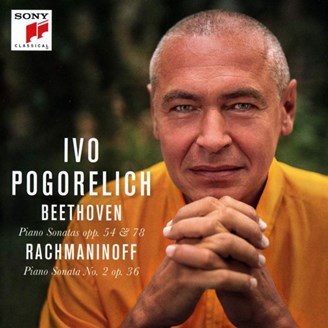
Four Scherzos
Ivo Pogorelich pf
(DG)
Love him or hate him, Pogorelich guarantees a response. Chopin for the faint-hearted this isn’t; original, provocative, challenging, daring, it emphatically is. Nevertheless, if Pogorelich’s most unconventional ideas approach wilful eccentricity, the rewards far outweigh any reservations. True, if they weren’t reinforced by such transcendent pianism Pogorelich’s interpretations wouldn’t carry nearly the same authority or conviction; but it’s precisely the marrying of his imaginative scope with his extraordinary technical resource that opens up such startling expressive possibilities.
The First and Second Scherzos show the juxtaposition of extremes at its most intense, stretching the limits of the musically viable. Predictably, the outer sections of the B minor Scherzo are incredibly fast, possessed of an almost demonic drive, while the central Polish carol (‘Sleep little Jesus’) is unusually slow and luxuriously sustained. But such extremes, of character as much as tempo, place enormous -tension on the musical structure, and this is most evident in the B flat minor Scherzo. Make no mistake, Pogorelich’s playing is astounding, from the imperious opening to the lingering and ravishing middle -section, where his sublime lyrical simplicity is of the deepest inward poetry.
To sum up, a recording like this isn’t easy. Some may find Pogorelich’s probing individualism too overwhelming. There are more ideas crammed into under 42 minutes than on many discs almost twice the length, although most collectors will still feel short-changed by the playing time. This may not be Chopin for every day, but the force of Pogorelich’s musical personality subtly and irrevocably shapes one’s view of the music. A truly extraordinary disc.
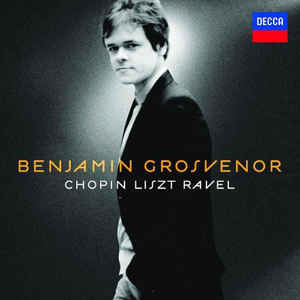
Four Scherzos. Nocturnes Nos 5, 19, 20
Benjamin Grosvenor pf
(Decca)
Benjamin Grosvenor is not only the first British pianist to be signed by Decca since the days of Clifford Curzon, Peter Katin and Moura Lympany, but also the youngest British artist ever to be signed to the label. Just as significantly, this acknowledgement has not come on the back of a major competition. Frankly, Grosvenor is too interesting and too individual to win any of them. His discs of minor Chopin (EMI, 3/10), his highly praised unofficial debut (“This and That”, 4/10), live recordings circulated privately over the past few years and this new one are evidence of an awesome talent, a pianist with fantastic natural reflexes in the Cziffra class and, more excitingly, a musician with purpose and imagination, whose playing transcends the sterile confines of the studio.
Having said that, I think he misjudges the first of the Four Scherzos (he orders them 1, 4, 3 and 2). It clocks in at 8’08”, compared with Rubinstein’s fast 8’20” (his 1932 recording), a tempo that reduces the first subject to the verge of incoherence. After this undeniably exciting reading, Grosvenor inserts a single Nocturne as a counterweight between each Scherzo. Good programming. (Louis Lortie did this on his recent excellent Chopin recital for Chandos; his B minor Scherzo, incidentally, lasts 9’26”.) I have never heard the filigree runs in the Nocturnes and two Chants polonais delivered with such innate improvisatory nonchalance, or a second part of the B flat minor Scherzo that can match Grosvenor’s delicious insouciance. This is music-making with a smile on its face.
Crowning it all is a masterly Gaspard in which an astonishing array of touch and tonal colouring are brought to bear in Grosvenor’s vivid, distinctly defined characterisation of all three movements. In brief, I am delighted that this prodigiously gifted young musician is on his way, on the right label and launched at last on what will surely be an important international career.
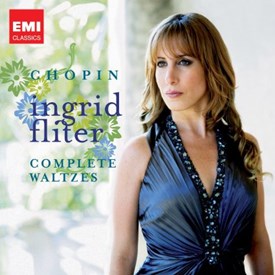
Complete Waltzes
Ingrid Fliter pf
(EMI/Warner Classics)
Presenting them in their published order, followed by the 11 posthumous waltzes with and without opus numbers, Ingrid Fliter sets a new benchmark for the complete Waltzes. From beginning to end, this is among the finest Chopin recordings of recent years.
Why? Each waltz emerges as if a great actress were reading a short story, each with its own colour and character. Fliter’s ‘timing’ (meaning her phrasing and rubato) is judged to perfection; her tempi are near ideal; she never loses sight of Chopin the poet or reinvents him as a red-blooded virtuoso. In addition, the superbly voiced piano is realistically recorded, neither too distant in that impersonal back-of-an-empty-hall way nor so close that the instrument is not allowed to sing.
Dip into any section of any Waltz at random and you will hear a version to supersede, or at least rival, your current personal favourite. Fliter stays faithful to the spirit of the composer without denying her own keyboard personality.

Complete Waltzes
Stephen Hough pf
Hyperion
Not all major pianists play Chopin but many who do have expressed a good deal of themselves through the Waltzes. They reveal a lot about a player and are merciless, it has been said, in showing up the limitations of an interpreter’s personality, and not just in the rhythm department. Brilliance and allure are required, of course, and so are reflective, interior qualities. The many repeated sections in the Waltzes can derail even cultivated pianists, who may keep your attention for a while but who then become predictable. Once predictability sets in, you tend to feel there is no hope.
Chopin would have had a fit at the thought of us listening to his eight published Waltzes together on the trot, or the unpublished ones which follow them here. Once engaged with Stephen Hough, though, you will stick with him, I feel sure, and with increasing pleasure: less is not more but not enough, and a cumulative quality begins to build that one is reluctant to break. My admiration for him as an artist increases, too, as one senses how responsive he is to Chopin’s variety, in a corpus of music not generally recognised as being so various. The demand for a special kind of virtuosity, directed towards the natural exuberance of the dance, he meets here to perfection, and he meets another challenge which the merely accomplished virtuoso may not even be aware of: to use sound to command precise musical character.
In making sequences of my own through the tracks, I’ve been delighted by the rediscoveries I’ve made, and also by new pleasures found among the slighter, less complex waltzes that Chopin allowed to circulate but did not publish. The nine securely authenticated pieces immediately follow the published ones here, a further three of more doubtful provenance being added after that. As compositions, the nine may not be as sophisticated as the concert waltzes, but are no less characteristic of him, and Hough shows they repay treatment as detailed and thoughtful as the rest require. In many other versions they do not get it, however, the moderately paced pieces being played too slowly and infected with a generalised wistfulness or, worse still, languor. Another of Hough’s strengths is to be found in the shape and direction he gives all the Waltzes, and in the freshness of his tone of voice. He can charm and beguile, and be bold in his contrasts, but he gets on with it, and it is the music he gives us, with true sentiments, and not merely a take on received ideas.
And what a lovely sound he makes – on a Yamaha, excellently recorded in a concert-hall acoustic. In textural terms he is up to the minute with current thinking, accepting that the interpreter should make choices among the variants existing for some of these pieces, in the same spirit as Chopin created them. More freshness, again. The recital is rounded off with the most waltz-like of the Nocturnes, the E flat major, Op 9 No 2 – a nice touch.
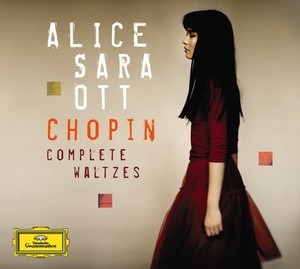
Complete Waltzes
Alice Sara Ott pf
DG 477 8095GH (57’ · DDD)
Only just out of her teens, Alice Sara Ott – half-German and half-Japanese – gives us a performance of the Waltzes as touching, piquant and scintillating as on any modern recording. She leaves you to marvel at her instinct for Chopin’s poetic ambiguity, his alternating melancholy and exuberance, his ultra-Slavonic hope and despair, her playing backed by the sheen of an immaculate technique and pianism. You will go a long way to hear the A minor Waltz confided with a greater sense of its intimacy or the following F major Waltz given with such contrasting brio and expressive freedom. Her D flat Waltz, Op 64, is sufficiently stylish and elegant to make nonsense of its sobriquet, ‘Minute’ Waltz, and she catches the B minor Waltz’s gentle but querulous mood to perfection. Playing from autograph manuscripts, she relishes the more florid harmony and ornamentation of, for example, Nos 8, 9 and 10, and includes all the posthumous Waltzes, ending with the Allegretto in A minor and making it a haunting and touching valediction. (DG’s sound is ideal and their presentation could hardly be more lavish.)
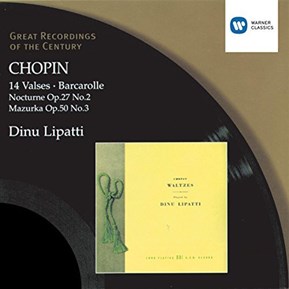
Waltzes Nos 1-14. Mazurka No 32. Barcarolle, Op 60. Nocturne in D flat
Dinu Lipatti pf
(Warner Classics)
Recorded 1947-50
As a former pupil of Cortot, it wasn’t perhaps surprising that Lipatti always kept a special place in his heart for Chopin. And thanks primarily to the 14 Waltzes, played in a non-chronological sequence of his own choosing, it’s doubtful if the disc will ever find itself long absent from the catalogue. Like the solitary Mazurka, they were recorded in Geneva during his remarkable renewal of strength in the summer of 1950. The Nocturne and Barcarolle date back to visits to EMI’s Abbey Road studio in 1947 and 1948 respectively. Just once or twice in the Waltzes you might feel tempted to question his sharp tempo changes for mood contrast within one and the same piece – as for instance in No 9 in A flat, Op 69 No 1. However, for the most part his mercurial lightness, fleetness and charm are pure delight. His Nocturnein D flat has long been hailed as one of the finest versions currently available. And even though we know he himself (one of the greatest perfectionists) was not completely happy about the Barcarolle, for the rest of us this glowing performance has a strength of direction and shapeliness all its own. In fuller contexts there’s just a trace of plumminess in the recorded sound.
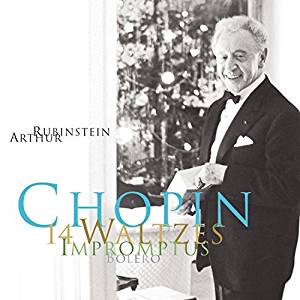
Waltzes Nos 1-14
Arthur Rubinstein pf
(RCA Red Seal)
Recorded 1960s
There has in recent years been a tendency to take Rubinstein’s imposing series of Chopin recordings from the mid-1960s for granted, but to hear them digitally refurbished soon puts a stop to that. His tone doesn’t have much luxuriance, being quite chiselled; yet a finely tuned sensibility is evident throughout. This is at once demonstrated by his direct interpretation of Op 18, its elegance explicit. His reading of Op 34 No 1 is brillante, as per Chopin’s title. In Op 34 No 2 Rubinstein judges everything faultlessly, distilling the sorrowful yet cannily varied grace of this piece. The two finest here are Opp 42 and 64 No 2, and with the former Rubinstein excels in the unification of its diverse elements, its rises and falls of intensity, its hurryings forward and holdings back. This is also true of his reading of Op 64 No 2, the yearning of whose brief più lento section is memorable indeed. The sole fault of this issue is that conventional programming leads to the mature Waltzes, which were published by Chopin himself, coming first, the lesser, posthumously printed items last. Not all of these are early but they have less substance than Opp 18-64, and should come first.
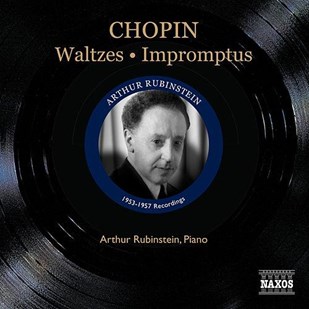
Waltzes Nos 1-14. Impromptus – Nos 1-3. Fantaisie-impromptu
Arthur Rubinstein pf
(Naxos)
Recorded 1953-57
This invaluable issue of recordings dating from the 1950s does yet more to Rubinstein’s status as the greatest of all Chopin pianists. Outwardly sober-suited and without the occasional wildnesses or mischievous emendations of the score that so delighted his capacity audiences, his relative reserve thinly disguises a heart of gold. Try Waltzes Nos 3, 7 and 13, where Rubinstein emphasises a melancholy and introspection far removed from the ballroom glitter of the more extrovert numbers, and you will realise that no other pianist has captured more subtly Chopin’s unique blend of classical bias and romantic freedom. Here in particular you note an elegance and insinuation devoid of all sentimentality, neurosis or self-serving idiosyncrasy.
Such quality is even more pronounced in the Impromptus, where Rubinstein’s musical breathing plays across the music’s surface like some gentle but enticing balm. His way with the bardic Second Impromptu is a poetic ultimate; here the Chopin of our dreams becomes a reality. There is not a single contemporary pianist who comes within distance of such playing. The Hollywood-based recordings are tight and dry.
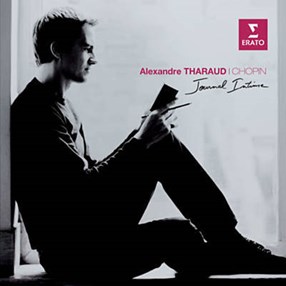
‘Journal intime’
Alexandre Tharaud pf
(Erato)
Here, in memorably refined and stylish performances, Tharaud is wonderfully enterprising, mixing the familiar and unfamiliar, the large-scale (despite his disc’s title, ‘Journal intime’) and the miniature. Everything is arrestingly personal yet never exaggerated or inflated, and his way with five Mazurkas, in particular, is very much at the heart of their confessional nature.
One misses the Berceuse, surely the most magical of all Chopin’s intimate creations, but relishes the variety achieved by including such grand works as the Fantasie and the First and Second Ballades. Here, as so often with Tharaud, there is an aristocratic balance of sense and sensibility, though his brilliant fury in the Second Ballade’s Presto storm is breathtaking, the left-hand octaves hurtling towards their apex like guided missiles.
Finally, in the evergreen E flat Nocturne, Op 9 No 2, Tharaud may be less enchanting than, say, Cherkassky but it is also a salutary reminder that Chopin was the most classically biased of the great keyboard composers. Finely recorded, this is an original and exemplary addition to Chopin’s bicentenary year.
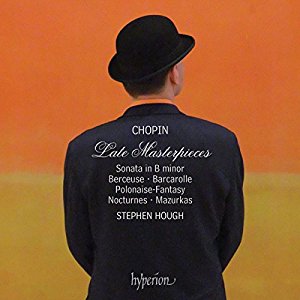
‘Late Masterpieces’
Stephen Hough pf
(Hyperion)
A new Hough disc is one of life’s pleasures. You know the programme will have been carefully considered and nurtured, every aspect of the performance and recording attended to in the finest detail, matched by Hyperion’s exacting standards of presentation. Hough’s Chopin can be a little emotionally chilly in a studio-perfect environment but here, for the most part, he transcends the lonely confines of St George’s (Bristol) to offer a masterclass in pianistic command and stylistic poise with the most heartfelt playing of any of his recent recordings. There are few who can elucidate the question-and-answer phrasing of Chopin’s music with Hough’s transparency and unaffected simplicity. Just listen to the opening Barcarolle, the selection of four Mazurkas, two Nocturnes and the closing Berceuse. At the centre of the recital is a masterly performance of the enigmatic Polonaise-fantaisie. In Hough’s hands, this discursive, experimental piece of great depth and beauty becomes an operatic aria. It seems to cry out for lyrics and a soprano.
After the first movement of the B minor Sonata (without the exposition repeat), Hough takes the Scherzo at a conservative molto vivace, while the finale, after one of those long-spun cantilena movements that Hough does so well, is an acutely executed studio recording. The disc’s striking cover has the Bowler-hatted Hough gazing at a Rothko abstract. The connection between Bowler, Rothko and Chopin is the subject of a thought-provoking essay by the pianist.
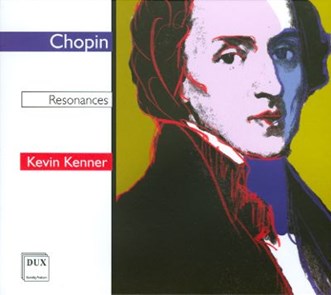
‘Chopin Resonances’
Kevin Kenner pf
(Dux)
This is Chopin presented with a difference. For here Kevin Kenner follows a reeling path, moving effortlessly from Chopin through related composers (Scriabin, Szymanowski et al) to Bill Evans and George Crumb. To crown everything, all the performances are of unwavering mastery and musicianship, with towering but never forced strength and a rubato and nuance both personal and telling. He is exceptionally glittering and stylish in Chopin’s Fantasie-impromptu (later making a ghostly reappearance in Crumb’s Dream Images) and offers a tantalising glimpse of Balakirev’s extensive but little-recorded repertoire in his Second Nocturne, music enriched with the composer’s elegant and conversational brilliance.
One mystery remains. Kenner’s own fine essay makes no mention of a lavish arrangement of Chopin’s Mazurka, Op 7 No 2. This is sufficiently piquant and startling to raise eyebrows. Everything is beautifully recorded on a light-toned instrument quite without alien heaviness or texture. This is a record to fascinate even the most blasé listener and one can scarcely wait to hear this superb and enterprising artist in further recordings.











